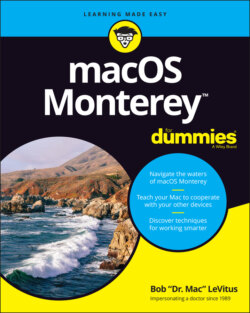Читать книгу macOS Monterey For Dummies - Bob LeVitus - Страница 45
The default icons of the dock
ОглавлениеBy default, the dock contains a number of commonly used macOS applications, and you can also store your own applications, files, or folders there. (I show you how to do that in the “Adding dock icons” section, later in this chapter.)
But first, look at the items you find in a standard macOS Monterey dock. If they aren’t familiar to you, they certainly will be as you get to know Monterey.
I admit that I can’t do justice to all the programs that come with macOS Monterey that aren’t, strictly speaking, part of the operating system (OS). Alas, some of the programs in the default dock are ones you won’t be seeing much more of. But I’d hate to leave you wondering what all those icons in the dock are, so the following list gives you a brief description of each default dock icon (moving from left to right onscreen). If additional coverage of an item appears elsewhere in the book, the list tells you where:
Finder: The always running application that manages the desktop, files, folders, disks, and more (this chapter and Chapters 4-8)
Launchpad: A display of all your applications on a grid that looks suspiciously like an iPad or iPhone (Chapter 10)
Safari: A web browser (Chapter 15)
Messages: A program for sending and receiving text and multimedia messages as well as transferring files to and from and remotely controlling other Macs (Chapter 17)
Mail: An email program (Chapter 17)
Maps: A program with maps and driving directions (Chapter 13)
FaceTime: A video chat program (Chapter 15)
Photos: A program for managing and editing photographs (Chapter 20)
FaceTime: A program for making and receiving audio and video calls (Chapter 15)
Calendar: A calendar program for managing appointments and events (Chapter 11)
Contacts: A contact manager application (Chapter 16)
Reminders: A to-do list and reminder application (Chapter 11)
Notes: A program for making notes (Chapter 11)
TV: A video player and store (Chapter 20)
Music: An audio player and store (Chapter 19)
Podcasts: A podcast player (Chapter 20)
News: A news reader (Chapter 14)
Mac App Store: Where you buy Mac apps from Apple (Chapter 23)
System Preferences: An application to configure the way many aspects of your Mac work (Chapters 6, 18, and 23)
Divider: The line that separates apps on the left and documents or folders on the right (this chapter)
Downloads folder: A folder that contains files downloaded by Safari or Mail (Chapter 4)
Trash: Where you drag files and folders to delete them, or drag removable media to eject it (this chapter)
To get a quick look at the name of a dock icon, just move (hover) your pointer over any item in the dock. Like magic, that item’s name appears above it (like Safari on the left side of Figure 3-4, later in this chapter).
It’s likely that your dock won’t look exactly like the one shown in Figure 3-1. If you added icons to your dock before you upgraded to Monterey, for example, you’ll see those icons. If you have Apple apps such as iMovie, GarageBand, Pages, Numbers, or Keynote installed, or you get a new Mac with Monterey preinstalled, you may see their icons in your dock. And if you’ve deleted one of the default icons shown in Figure 3-1 from your dock under a previous version of macOS, it won’t come back when you upgrade to Monterey.
If you don’t understand what I just said or want to make your dock look exactly like the one shown in Figure 3-1, I have good news : You find out how to do that and much more before the end of this chapter.
Also, if you see a question mark instead of an icon in the dock, the file (application, document, or folder) it represents has been deleted.
